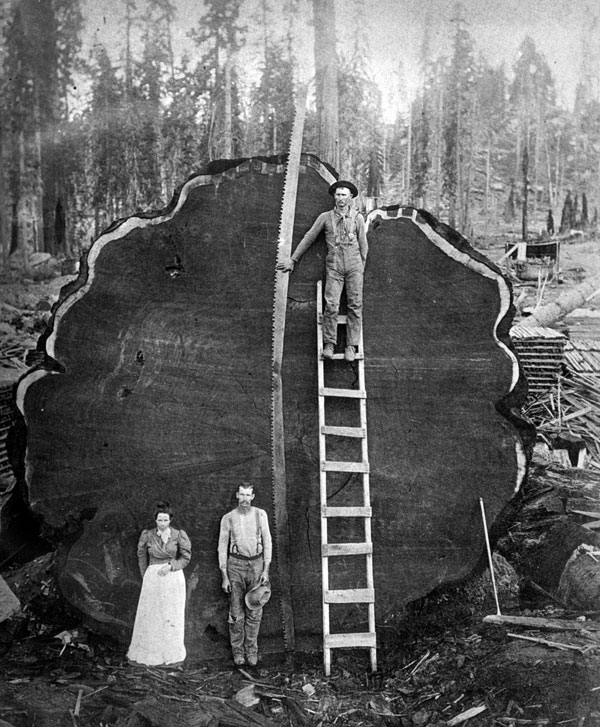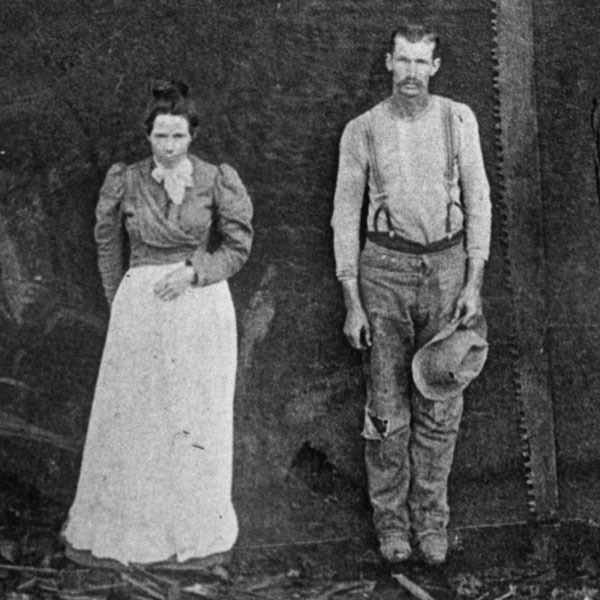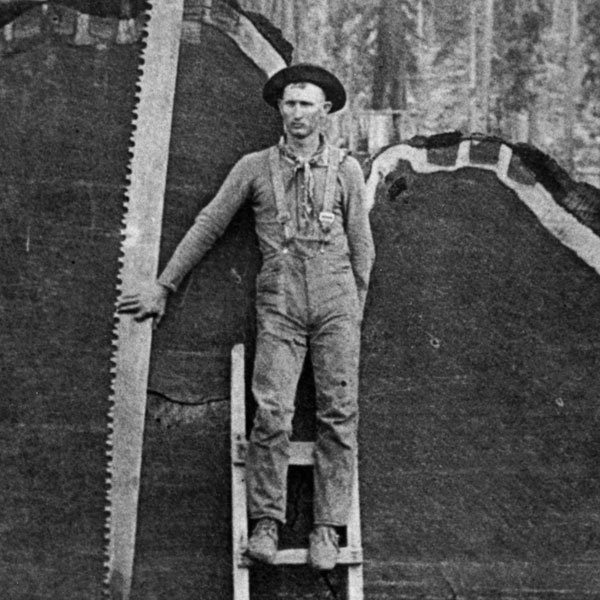
I was captivated by this photo someone shared on Twitter and tracked it down in the Library of Congress archives. It’s an undated, uncredited picture of what some have dubbed the “Mark Twain Tree” (which is how it was titled on the Twitter post). I can’t confirm this (and, in fact, I doubt it; see below for my reasoning), but if it’s true, this California sequoia was felled in 1891 at the age of 1,341 years, according to this website. The tree was 331 feet tall, and the base of its trunk measured 90 feet in circumference. Although a couple of cross sections were saved, the rest of the massive tree went to make “grape stakes, fence posts and shingles.”
Those are the facts surrounding this image, and they comprise a remarkable story on their own.
On the other hand…I have questions. Questions that might generate other stories. Let’s take a closer look at parts of the photo, and wonder…

- Who are these people? Are they married? If so, why are they standing apart from each other?
- On a related note, is the fact that the man is standing closer to the saw than to the woman meaningful?
- What was the woman’s role at the job site?
- The woman seems to be dressed more formally than one might expect at a lumber harvesting operation. Was she a visitor?
- Her expression doesn’t seem to indicate that she’s happy to be there. Is there a reason other than that was the typical expression for photographic subjects during that era?
- The man’s garb, on the other hand, is well-worn, even shabby. But should we assume that he was a member of the team who felled the tree?
Let’s move to the man on the ladder…

- It’s not readily evident from the full photo, but this man is missing part of his right forefinger. How did he lose it?
- Is that a wound on his forehead, or simply a strange hair pattern?
- The ladder on which he’s standing is obviously hand-built. Was he nervous about mounting and posing on it?
There are a couple of tools in the photo…

- What was the purpose of the mallet (seen at the lower left of the original photo)? Was is used to drive wedges into the cut to keep the saw from binding?
- The white rod (seen leaning against the tree on the right of the photo) might possibly be a sort of crowbar, but it doesn’t appear metallic. What was its composition and purpose?
- And while we’re cogitating on the tools, how about that saw? If the circumference was 90′, the diameter was almost 30′ and you’d want a few feet extra for a good cutting action. Who made saws that long? From a distance, the photo suggests that two saws were welded together, but a closeup shows no obvious seam. Also, the saw is bowed along its length, rather than being straight. Did this provide more control of the cut, or is it designed to speed up the cut?
- However…the man standing on the ground is perhaps 6 feet tall. The trunk he’s standing in front of is not five times his height…it’s closer to three, making the circumference less than 60 feet. Assuming the 90′ circumference reported for the Mark Twain Tree is true, this cannot be the same tree. So, where and when was this photo taken?
- How long did it take to cut down the tree? Hours? Days? Did it fall precisely where the lumberjacks intended?
- Once the tree was felled, at least two additional cuts were made to create the cross sections mentioned in the article linked above. This implies that the saw operators worked from ladders on either side of the trunk. We might imagine that the sawing itself would be easier, but balancing on ladders surely complicated the process. Were there any ladder-related mishaps?
- And, finally, did those who cut down this centuries old tree feel any remorse at their actions?
In the cosmic scheme of things, none of these questions are important. My point in raising them is simply to suggest that curiosity about seemingly trivial details might lead to fascinating stories, when answered with imagination and creativity. That’s your assignment for the day.
Discover more from The Fire Ant Gazette
Subscribe to get the latest posts sent to your email.
